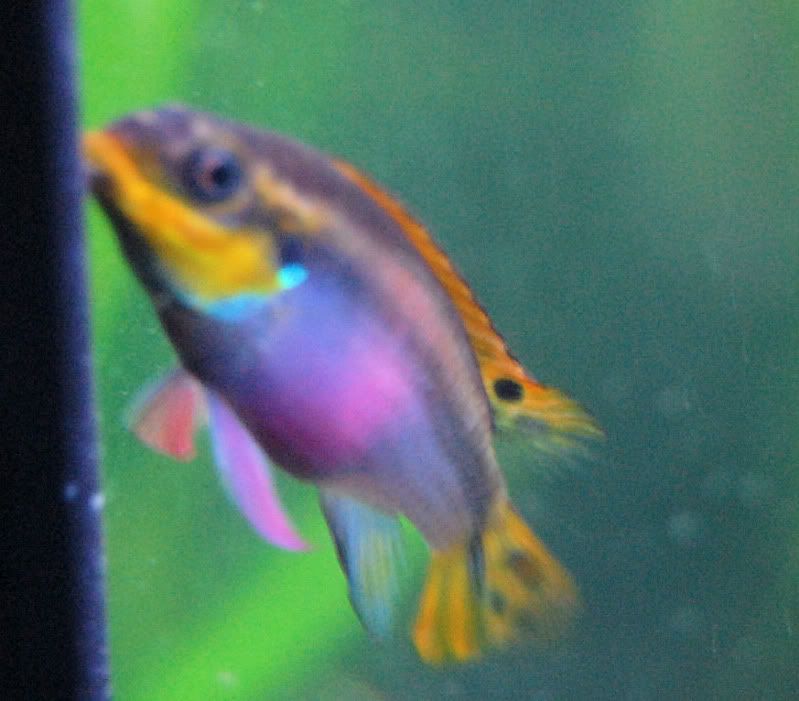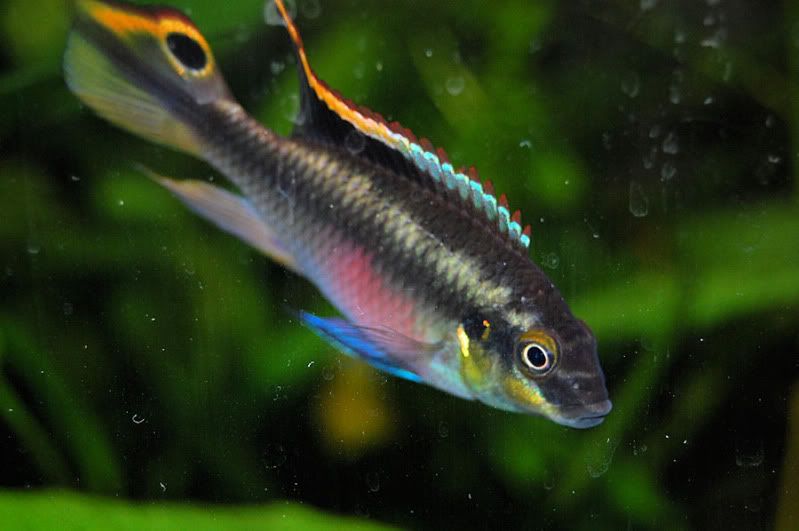JohnRossDele
Fish Herder
Kribensis Breeding, a Guide.
If your looking to breed kribs for fun, as a hobby or just for the profit you've come to the right place!!
my pair of kribs

Introduction
Breeding kribs is fun, educational and a very relaxing scene! The colouration of the pair as they are in spawning mode is a beautiful sight to behold in a well lit tank with a natural aqua scape. Their colours of red, olive, gold, black, white and yellow become more intense as the two start to breed.
Supplies Needed
A tank & stand: Anything over 60 litres (~ 15 gallons)
Heater: make sure it is suited to the size of your fish tank
A fry-safe filter: such as the u series from fluval (the spray bar on them has next to no current creation, or a sponge filter)
Liquid Test Kit (test strips are inaccurate)
A thermometer
Decorations: Caves of some sort.
Plants: live or artificial will be fine.
Substrate: Sand or fine gravel.
Food for the parents: frozen brine shrimp, sinking pellets & algae flakes, anything with a good amount of protein
Food for the fry: baby brine shrimp & crushed flakes
Kribs: A proven pair, or a group of 6 (once a pair forms the others will need to be removed).
Tank background (optional)
How to set-up a Tropical Freshwater Aquarium
1) Choose the position for your tank, make sure there is no direct sunlight reaching the aquarium, remove anything from this area and ensure the area is clean.
2) Put the stand in place and check with a spirit level if it is level.
3) Put the tank on the stand, make sure it isn't overhanging.
4) Rinse substrate: For bigger grained gravel wash your substrate thoroughly in a pasta stainer, for sand or tiny grained gravel rinse in a basin and place inside aquarium
5) Ensure you place: filter, heater, decorations, caves (kribs need a cave to breed in) ect. inside the aquarium
6) Add dechlorinator to the tank and fill the tank with water to roughly three quarters full,switch the heater and the filter on.
7) When you've done, fill the aquarium completely, and place a thermometer on the outsider (for stick on thermometers) and place on inside wall of aquarium (for waterproof suction cup mounted thermometers)
8) Run the tank for a day before starting your fishless cycle.
Link to fishless cycle: click here
Steps for Successful Breeding
1) Before adding kribs, make sure your filter and heater are in good working order, and the cycle has finished.
2) Add a proven pair of kribs or a group of about 6 kribs and wait. It may take up to 10-12 weeks for the pair to breed which includes waiting for the kribs to settle in and 3-8 days for the eggs to hatch, so be patient. If you chose to add a group of 6, once a pair has formed, remove the other 4. Kribs breed in caves so be sure to use a half buried plant pot or a DIY coconut cave.
3) Krib fry should be fed on crushed flakes for the first week or two (baby brine shrimp is optional), parents are extremely protective of their young at this point! So don't plan on getting any fish apart from the parents and the fry. Sometimes the krib pair will gather all of the fry into his or her mouth, don't be alarmed as this is only the mother or father protecting them against other fish that may be in the tank, though it is not recommended to add other fish to a breeding tank to avoid predation of the fry.
4) Continue to look after fry and keep checking those water stats to make sure the ammonia, nitrIte or nitrAte don't go off the regular as this could be detrimental to the fry and adults.
5) Take fry out when the female starts to egg up again (when her belly looks very fat, almost like she swallowed a marble) she will view the older fry as intruders and will most likely attack them when caring for the new brood. Use a tank approximately the same size as the breeding tank to grow out the fry to a sellable size.
6) Last but very not least: change from finely crushed flakes to slightly crushed flakes and then on to non-crushed flakes in a period of up to 4 months changing every month and a half or so. After this feed pellets, at this point fry will be developing colour and beginning to mature. At 7 months they should reach a sellable size!
Done

Additional Tips and Tricks
Keep kribs in in a 60 litre+ tank (the hagen elite style 95 is an excellent choice) with 2 or more caves, a fine substrate (easy for fish to dig in), driftwood, rocks, plants and floating plants & maybe a choice of some other decor that would match a quiet, natural scene from West Africa.
Why not give DIY coconut caves a go, they are fun to make and are a very good size and shape cave for females to lay eggs in
While kribs, being a very hardy fish, will adapt to most water conditions, you should keep the PH at a constant 7.0. Anything below or above this will normally result in same sex fry.
Choosing kribs is a very enjoyable task, but make sure you choose an even number of males and females. Some shops or online stores will sell proven pairs.
Never let your krib fry be in the same tank as the parents for more than 2 months because they will take them as intruders in future broods, kribs will normally reach a sellable size at 1 inch
fry can be pretty hardy. It is not unheard of finding fry living in filters!
Never buy weak, injured or diseased kribs, it will cost you a lot of time to cure them (if possible) and they will never breed in these conditions!
Kribs lay their egg's in the roof of a cave, the female lays them and the male fertilies them.
Add lots of plants to the aquarium, this will make the kribs/fry feel more secure.
perform weekly 25% water changes to the fry tank, this will speed up growth in the fry
How to make a DIY coconut cave: click here
How to identify the gender of Male & Female Kribensis:
Female:
Females are slightly smaller than males, they have more of a yellowish colour, their bellys are more rounded also being ruby red and they have an eye spot on their dorsal fin.

Males:
Males are slightly larger, they have more extended dorsal and anal fins, their fins have more eye spots and they are less colourful

It is recommended that you get a larger male to start off with because the female will batter the male if he does not breed, the bigger size will prevent this since the bigger the stronger they are! also make sure you don't get two males as they will fight with each other.
Kribensis before laying eggs and pairing up will perform the method courtship, mostly preformed by the female to attract the male, the females will dash around the tank after the male showing off her beautiful belly to the male. The bigger the belly the more chance the male will want to breed with her, as a bigger belly is more attractive to the males, high protein foods encourage the kribs to breed (interpet brine shrimp cubes will work) this makes the fish colour up more and also makes them want to breed.
Kribensis overall colour gets more intense as they start to breed.
Thank you for reading, these steps will ensure you and your future colony of kribs will live safe and happily!

If your looking to breed kribs for fun, as a hobby or just for the profit you've come to the right place!!
my pair of kribs

Introduction
Breeding kribs is fun, educational and a very relaxing scene! The colouration of the pair as they are in spawning mode is a beautiful sight to behold in a well lit tank with a natural aqua scape. Their colours of red, olive, gold, black, white and yellow become more intense as the two start to breed.
Supplies Needed
A tank & stand: Anything over 60 litres (~ 15 gallons)
Heater: make sure it is suited to the size of your fish tank
A fry-safe filter: such as the u series from fluval (the spray bar on them has next to no current creation, or a sponge filter)
Liquid Test Kit (test strips are inaccurate)
A thermometer
Decorations: Caves of some sort.
Plants: live or artificial will be fine.
Substrate: Sand or fine gravel.
Food for the parents: frozen brine shrimp, sinking pellets & algae flakes, anything with a good amount of protein
Food for the fry: baby brine shrimp & crushed flakes
Kribs: A proven pair, or a group of 6 (once a pair forms the others will need to be removed).
Tank background (optional)
How to set-up a Tropical Freshwater Aquarium
1) Choose the position for your tank, make sure there is no direct sunlight reaching the aquarium, remove anything from this area and ensure the area is clean.
2) Put the stand in place and check with a spirit level if it is level.
3) Put the tank on the stand, make sure it isn't overhanging.
4) Rinse substrate: For bigger grained gravel wash your substrate thoroughly in a pasta stainer, for sand or tiny grained gravel rinse in a basin and place inside aquarium
5) Ensure you place: filter, heater, decorations, caves (kribs need a cave to breed in) ect. inside the aquarium
6) Add dechlorinator to the tank and fill the tank with water to roughly three quarters full,switch the heater and the filter on.
7) When you've done, fill the aquarium completely, and place a thermometer on the outsider (for stick on thermometers) and place on inside wall of aquarium (for waterproof suction cup mounted thermometers)
8) Run the tank for a day before starting your fishless cycle.
Link to fishless cycle: click here
Steps for Successful Breeding
1) Before adding kribs, make sure your filter and heater are in good working order, and the cycle has finished.
2) Add a proven pair of kribs or a group of about 6 kribs and wait. It may take up to 10-12 weeks for the pair to breed which includes waiting for the kribs to settle in and 3-8 days for the eggs to hatch, so be patient. If you chose to add a group of 6, once a pair has formed, remove the other 4. Kribs breed in caves so be sure to use a half buried plant pot or a DIY coconut cave.
3) Krib fry should be fed on crushed flakes for the first week or two (baby brine shrimp is optional), parents are extremely protective of their young at this point! So don't plan on getting any fish apart from the parents and the fry. Sometimes the krib pair will gather all of the fry into his or her mouth, don't be alarmed as this is only the mother or father protecting them against other fish that may be in the tank, though it is not recommended to add other fish to a breeding tank to avoid predation of the fry.
4) Continue to look after fry and keep checking those water stats to make sure the ammonia, nitrIte or nitrAte don't go off the regular as this could be detrimental to the fry and adults.
5) Take fry out when the female starts to egg up again (when her belly looks very fat, almost like she swallowed a marble) she will view the older fry as intruders and will most likely attack them when caring for the new brood. Use a tank approximately the same size as the breeding tank to grow out the fry to a sellable size.
6) Last but very not least: change from finely crushed flakes to slightly crushed flakes and then on to non-crushed flakes in a period of up to 4 months changing every month and a half or so. After this feed pellets, at this point fry will be developing colour and beginning to mature. At 7 months they should reach a sellable size!
Done
Additional Tips and Tricks
Keep kribs in in a 60 litre+ tank (the hagen elite style 95 is an excellent choice) with 2 or more caves, a fine substrate (easy for fish to dig in), driftwood, rocks, plants and floating plants & maybe a choice of some other decor that would match a quiet, natural scene from West Africa.
Why not give DIY coconut caves a go, they are fun to make and are a very good size and shape cave for females to lay eggs in
While kribs, being a very hardy fish, will adapt to most water conditions, you should keep the PH at a constant 7.0. Anything below or above this will normally result in same sex fry.
Choosing kribs is a very enjoyable task, but make sure you choose an even number of males and females. Some shops or online stores will sell proven pairs.
Never let your krib fry be in the same tank as the parents for more than 2 months because they will take them as intruders in future broods, kribs will normally reach a sellable size at 1 inch
fry can be pretty hardy. It is not unheard of finding fry living in filters!
Never buy weak, injured or diseased kribs, it will cost you a lot of time to cure them (if possible) and they will never breed in these conditions!
Kribs lay their egg's in the roof of a cave, the female lays them and the male fertilies them.
Add lots of plants to the aquarium, this will make the kribs/fry feel more secure.
perform weekly 25% water changes to the fry tank, this will speed up growth in the fry
How to make a DIY coconut cave: click here
How to identify the gender of Male & Female Kribensis:
Female:
Females are slightly smaller than males, they have more of a yellowish colour, their bellys are more rounded also being ruby red and they have an eye spot on their dorsal fin.

Males:
Males are slightly larger, they have more extended dorsal and anal fins, their fins have more eye spots and they are less colourful

It is recommended that you get a larger male to start off with because the female will batter the male if he does not breed, the bigger size will prevent this since the bigger the stronger they are! also make sure you don't get two males as they will fight with each other.
Kribensis before laying eggs and pairing up will perform the method courtship, mostly preformed by the female to attract the male, the females will dash around the tank after the male showing off her beautiful belly to the male. The bigger the belly the more chance the male will want to breed with her, as a bigger belly is more attractive to the males, high protein foods encourage the kribs to breed (interpet brine shrimp cubes will work) this makes the fish colour up more and also makes them want to breed.
Kribensis overall colour gets more intense as they start to breed.
Thank you for reading, these steps will ensure you and your future colony of kribs will live safe and happily!


